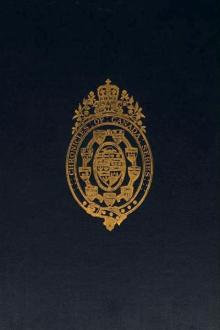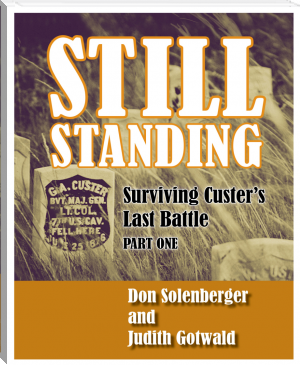The Mariner of St Malo, Stephen Leacock [the top 100 crime novels of all time .txt] 📗

- Author: Stephen Leacock
- Performer: -
Book online «The Mariner of St Malo, Stephen Leacock [the top 100 crime novels of all time .txt] 📗». Author Stephen Leacock
When the customary ceremonies of eating and drinking, speech-making, and presentations had ended, Cartier, after first exploring with his boats, sailed with his ships a few miles above Stadacona to a little river where good anchorage was found, now known as the Cap Rouge river. It enters the St Lawrence a little above Quebec.
Here preparations were at once made for the winter’s sojourn. Cannon were brought ashore from three of the ships. A strong fort was constructed, and the little settlement received the pretentious name Charlesbourg Royal. The remaining part of the month of August 1541
was spent in making fortifications and in unloading the ships. On September 2 two of the ships, commanded by Mace Jalobert, Cartier’s brother-in-law and companion of the preceding voyage, and Etienne Nouel, his nephew, were sent back to France to tell the king of what had been done, and to let him know that Roberval had not yet arrived.
As on his preceding voyages, Cartier was greatly impressed by the aspect of the country about him. All round were splendid forests of oak and maple and cedar and beech, which surpassed even the beautiful woodlands of France.
Grape vines loaded with ripe fruit hung like garlands from the trees. Nor was the forest thick and tangled, but rather like an open park, so that among the trees were great stretches of ground wanting only to be tilled.
Twenty of Cartier’s men were set to turn the soil, and in one day had prepared and sown about an acre and a half of ground. The cabbage, lettuce, and turnip seed that they planted showed green shoots within a week.
At the mouth of the Cap Rouge river there is a high point, now called Redclyffe. On this Cartier constructed a second fort, which commanded the fortification and the ships below. A little spring supplied fresh water, and the natural situation afforded a protection against attack by water or by land. While the French laboured in building the stockades and in hauling provisions and equipments from the ships to the forts, they made other discoveries that impressed them more than the forest wealth of this new land. Close beside the upper fort they found in the soil a good store of stones which they ‘esteemed to be diamonds.’ At the foot of the slope along the St Lawrence lay iron deposits, and the sand of the shore needed only, Cartier said, to be put into the furnace to get the iron from it. At the water’s edge they found ‘certain leaves of fine gold as thick as a man’s nail,’ and in the slabs of black slate-stone which ribbed the open glades of the wood there were veins of mineral matter which shone like gold and silver. Cartier’s mineral discoveries have unfortunately not resulted in anything. We know now that his diamonds, still to be seen about Cap Rouge, are rock crystals. The gold which he later on showed to Roberval, and which was tested, proved genuine enough, but the quantity of such deposits in the region has proved insignificant. It is very likely that Cartier would make the most of his mineral discoveries as the readiest means of exciting his master’s interest.
When everything was in order at the settlement, the provisions landed, and the building well under way, the leader decided to make a brief journey to Hochelaga, in order to view more narrowly the rapids that he had seen, and to be the better able to plan an expedition into the interior for the coming spring. The account of this journey is the last of Cartier’s exploits of which we have any detailed account, and even here the closing pages of his narrative are unsatisfactory and inconclusive.
What is most strange is that, although he expressly says that he intended to ‘go as far as Hochelaga, of purpose to view and understand the fashion of the saults [falls]
of water,’ he makes no mention of the settlement of Hochelaga itself, and does not seem to have visited it.
The Hochelaga expedition, in which two boats were used, left the camp at Cap Rouge on September 7, 1541. A number of Cartier’s gentlemen accompanied him on the journey, while the Viscount Beaupre was left behind in command of the fort. On their way up the river Cartier visited the chief who had entrusted his little daughter to the case of the French at Stadacona at the time of Cartier’s wintering there. He left two young French boys in charge of this Indian chief that they might learn the language of the country. No further episode of the journey is chronicled until on September 11 the boats arrived at the foot of the rapids now called Lachine. Cartier tells us that two leagues from the foot of the bottom fall was an Indian village called Tutonaguy, but he does not say whether or not this was the same place as the Hochelaga of his previous voyage. The French left their boats and, conducted by the Indians, walked along the portage path that led past the rapids. There were large encampments of natives beside the second fall, and they received the French with every expression of good-will. By placing little sticks upon the ground they gave Cartier to understand that a third rapid was to be passed, and that the river was not navigable to the country of Saguenay.
Convinced that further exploration was not possible for the time being, the French returned to their boats. As usual, a great concourse of Indians had come to the spot.
Cartier says that he ‘understood afterwards’ that the Indians would have made an end of the French, but judged them too strong for the attempt. The expedition started at once for the winter quarters at Cap Rouge. As they passed Hochelay—the abode of the supposed friendly chief near Portneuf—they learned that he had gone down the river ahead of them to devise means with Agouhanna for the destruction of the expedition.
Cartier’s narrative ends at this most dramatic moment of his adventures. He seems to have reached the encampment at Cap Rouge at the very moment when an Indian assault was imminent. We know, indeed, that the attack, which, from certain allusions in the narrative, seems presently to have been made, was warded off, and that Cartier’s ships and a part at least of his company sailed home to France, falling in with Roberval on the way. But the story of the long months of anxiety and privation, and probably of disease and hostilities with the Indians, is not recorded. The narrative of the great explorer, as it is translated by Hakluyt, closes with the following ominous sentences:
‘And when we were arrived at our fort, we understood by our people that the savages of the country came not any more about our fort, as they were accustomed, to bring us fish, and that they were in a wonderful doubt and fear of us. Wherefore our captain, having been advised by some of our men which had been at Stadacona to visit them that there was a wonderful number of the country people assembled together, caused all things in our fortress to be set in good order.’ And beyond these words, Cartier’s story was never written, or, if written, it has been lost.
THE CLOSE OF CARTIER’S CAREER
Great doubt and uncertainty surround the ultimate fate of Roberval’s attempted colony, of which Cartier’s expedition was to form the advance guard. Roberval, as already seen, had stayed behind in France when Cartier sailed in 1541, because his equipment was not yet ready for the voyage. Nor does he seem to have finally started on his expedition for nearly a year after the departure of Cartier. It has been suggested that Roberval did set sail at some time in the summer of 1541, and that he reached Cape Breton island and built a fort there. So, at least, a tradition ran that was repeated many years later by Lescarbot in his Histoire de la Nouvelle France.
If this statement is true, it must mean that Roberval sailed home again at the close of 1541, without having succeeded in finding Cartier, and that he prepared for a renewed expedition in the spring of the coming year.
But the evidence for any such voyage is not conclusive.
What we know is that on April 16, 1542, Roberval sailed out of the port of Rochelle with three tall ships and a company of two hundred persons, men and women, and that with him were divers gentlemen of quality. On June 8, 1542, his ships entered the harbour of St John’s in Newfoundland. They found there seventeen fishing vessels, clear proof that by this time the cod fisheries of the Newfoundland Banks were well known. They were, indeed, visited by the French, the Portuguese, and other nations.
Here Roberval paused to refit his ships and to replenish his stores. While he was still in the harbour, one day, to his amazement, Cartier sailed in with the five ships that he was bringing away from his abandoned settlement at Charlesbourg Royal. Cartier showed to his superior the ‘diamonds’ and the gold that he was bringing home from Canada. He gave to Roberval a glowing account of the country that he had seen, but, according to the meagre details that appear in the fragment in Hakluyt’s Voyages, he made clear that he had been compelled to abandon his attempt at settlement. ‘He could not with his small company withstand the savages, which went about daily to annoy him, which was the cause of his return into France.’
Except what is contained in the few sentences of this record we know nothing of what took place between Roberval and Cartier. But it was quite clear that the latter considered the whole enterprise as doomed to failure. It is more than likely that Cartier was dissatisfied with Roberval’s delay, and did not care to continue under the orders of a leader inferior to himself in capacity. Be this as it may, their final parting stands recorded in the following terms, and no historical document has as yet come to light which can make the exact situation known to us. ‘When our general [Roberval], being furnished with sufficient forces, commanded him [Cartier] to go back with him, he and his company, moved as it seems with ambition, because they would have all the glory of the discovery of those parts themselves, stole privily away the next night from us, and, without taking their leaves, departed home for Brittany.’ The story, it must be remembered, comes from the pen of either Roberval or one of his associates.
The subsequent history of Roberval’s colony, as far as it is known, can be briefly told. His ships reached the site of Charlesbourg Royal late in July 1542. He landed stores and munitions and erected houses, apparently on a scale of some magnitude, with towers and fortifications and with great kitchens, halls, and living rooms. Two ships were sent home in the autumn with news of the expedition, their leader being especially charged to find out whether the rock crystals carried back by Cartier had turned out to be diamonds. All the other colonists remained and spent the winter in this place. In spite of their long preparation and of their commodious buildings, they seem to have endured sufferings as great as, or even greater than, those of Cartier’s men at Stadacona seven years before. Supplies of food ran short, and even in the autumn before the stern winter had begun it was necessary to put the whole company on carefully





Comments (0)